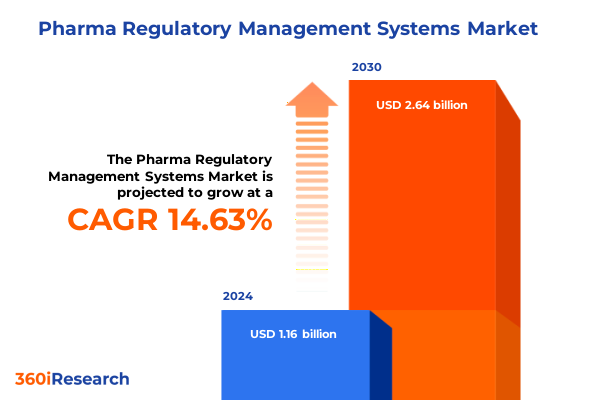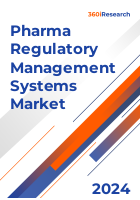The Pharma Regulatory Management Systems Market size was estimated at USD 1.16 billion in 2024 and expected to reach USD 1.33 billion in 2025, at a CAGR 14.63% to reach USD 2.64 billion by 2030.

Introduction to Pharma Regulatory Management Systems
Pharmaceutical regulatory management systems have become indispensable as industry stakeholders grapple with complex compliance requirements, accelerating innovation pipelines, and rising scrutiny from global authorities. Organizations that once relied on manual processes and disparate tools now face intense pressure to adopt integrated platforms that streamline document lifecycle management, automate approval workflows, and ensure real-time audit readiness. This transition is fueled by the dual mandate to reduce time-to-market while maintaining the highest standards of safety and efficacy. Against this backdrop, regulatory intelligence must evolve from a static repository into a dynamic engine that anticipates policy shifts, flags emerging risks, and supports decision-making across R&D, manufacturing, and commercialization.
The following summary examines pivotal market dynamics, highlights the influence of recent tariff adjustments, explores segmentation intricacies, and identifies regional and competitive forces shaping the future of regulatory management technology. It also offers targeted recommendations for C-suite executives and decision-makers seeking to optimize compliance operations and accelerate digital transformation initiatives.
Transformative Shifts in Regulatory Management Systems
Over the past decade, regulatory management has shifted from siloed applications to unified ecosystems that leverage cloud computing, artificial intelligence, and advanced analytics. This transformation has manifested in three key trends. First, interoperability has advanced beyond basic data exchange, enabling seamless integration between drug approval systems, safety monitoring modules, and audit-trail repositories. Second, user experience has risen to strategic importance; feedback mechanisms and customizable dashboards now guide interface development, ensuring that compliance officers, clinical researchers, and quality managers can access critical insights at a glance. Third, predictive analytics and machine learning algorithms have begun to forecast regulatory outcomes by analyzing historical submission data and policy patterns, thus reducing uncertainty and accelerating approval timelines.
These transformative shifts reflect a broader industry push toward proactive compliance governance, where risk management and quality assurance are embedded within every phase of the product lifecycle. Building on this momentum, stakeholders can address emerging challenges such as global harmonization, data privacy constraints, and resource optimization more effectively.
Cumulative Impact of United States Tariffs 2025 on System Adoption
The implementation of new tariffs in the United States, effective as of January 2025, has directly influenced procurement costs, project budgets, and deployment strategies for regulatory management platforms. Increased duties on imported servers and data storage devices have compelled organizations to reevaluate their hardware acquisition plans, with many turning to domestic manufacturers or hybrid cloud architectures to mitigate cost pressures. Meanwhile, tariffs on certain software licenses have prompted a shift toward modular, subscription-based licensing models that allocate expenses as operational costs rather than capital expenditures.
Supply chain recalibrations have also gained prominence: affected vendors now maintain contingency plans that include local assembly points, regional data centers, and multi-tier sourcing strategies to ensure continuity. As a result, stakeholders must incorporate tariff-induced cost variances into total cost of ownership calculations and vendor selection criteria. By anticipating these fiscal headwinds and aligning procurement frameworks accordingly, organizations can safeguard compliance progress and maintain momentum in their digital transformation journeys.
Key Segmentation Insights Driving Market Differentiation
A nuanced understanding of market segments reveals distinct opportunities and priorities. Within system components, organizations weigh the benefits of data storage devices and servers against those of customizable architectures and interoperable interfaces, while compliance management modules, drug approval systems, and workflow automation tools form the backbone of their software investments. End-user verticals span biotechnology firms-both established corporations and agile startups-and contract research organizations offering clinical trial management alongside regulatory consultancy, as well as pharmaceutical companies that encompass both biologics developers and generic manufacturers. Deployment models range from hybrid, private, and public cloud solutions to in-house infrastructure and locally hosted software, each offering trade-offs in scalability, security, and cost predictability.
Functionality priorities further diversify the landscape: alerts and notification systems enhance compliance tracking, storage and retrieval capabilities underpin robust document management, and approval monitoring paired with task automation streamlines regulatory workflows. Industry applications focus on clinical trials across Phases I, II, and III, while product launches demand solutions that handle labeling, packaging, and pre-marketing approvals. Business size also influences selection criteria, with large enterprises driving demand for enterprise-grade platforms, medium enterprises seeking balanced feature sets, and small enterprises favoring modular, cost-effective tools. Additionally, quality assurance anchored in standard operating procedures and risk management frameworks featuring issue reporting and safety protocols remain essential. Innovation trends-such as automation tools, predictive analytics, deep data mining, and real-time reporting-intersect with enhancements in user experience, including user surveys and customizable dashboards, to define the competitive frontier.
This comprehensive research report categorizes the Pharma Regulatory Management Systems market into clearly defined segments, providing a detailed analysis of emerging trends and precise revenue forecasts to support strategic decision-making.
- System Components
- End-User Verticals
- Deployment Models
- System Functionality
- Industry Applications
- Business Size
- Process Outcomes
- Innovation Trends
- User Experience Enhancements
Regional Dynamics Shaping Adoption and Innovation
Regional dynamics have emerged as a critical determinant of platform design and adoption. In the Americas, proactive regulatory harmonization initiatives and strong investment in cloud infrastructure accelerate uptake of integrated systems, particularly among organizations seeking to streamline FDA submissions and post-market surveillance. Shifting focus to Europe, Middle East & Africa reveals a mosaic of regulatory frameworks that emphasize data localization, privacy compliance, and multilingual support, driving demand for platforms that can adapt to regional and country-specific requirements. In the Asia-Pacific, rapid growth in emerging markets, combined with government incentives for digital health transformation, propels adoption of cloud-based systems-especially hybrid models that balance global best practices with local data residency mandates.
Together, these regional insights underscore the importance of flexible architectures, multi-language interfaces, and strategic partnerships with local service providers to ensure broad market penetration and compliance alignment.
This comprehensive research report examines key regions that drive the evolution of the Pharma Regulatory Management Systems market, offering deep insights into regional trends, growth factors, and industry developments that are influencing market performance.
- Americas
- Asia-Pacific
- Europe, Middle East & Africa
Strategic Moves by Leading Solution Providers
A diverse array of solution providers competes to define the future of regulatory management. Antares Vision S.p.A., ArisGlobal LLC and arivis AG by Carl Zeiss AG lead with end-to-end platforms that integrate data visualization, traceability, and compliance analytics. Dassault Systèmes S.E. and DDi Smart Technology leverage digital-twin simulations and advanced data science to optimize quality control and change management. The Dovel Group and Ennov Group deliver modular compliance suites tailored to complex regulatory environments, while EXTEDO GmbH and Freyr Software Services Pvt. Ltd. specialize in regulatory information exchange and submission workflow automation. Informa PLC and Instem PLC focus on harmonizing safety reporting and clinical data management, whereas IQVIA Inc. and MasterControl Inc. excel at life-cycle management and continuous process improvement. NNIT GROUP and pharmaREADY by Navitas Life Sciences offer consultancy-driven implementations, and Veeva Systems Inc. sets the standard for cloud-native, unified regulatory, quality, and pharmacovigilance solutions.
This comprehensive research report delivers an in-depth overview of the principal market players in the Pharma Regulatory Management Systems market, evaluating their market share, strategic initiatives, and competitive positioning to illuminate the factors shaping the competitive landscape.
- Antares Vision S.p.A.
- ArisGlobal LLC
- arivis AG by Carl Zeiss AG
- Dassault Systèmes S.E.
- DDi Smart Technology
- Dovel Group
- Ennov Group
- EXTEDO GmbH
- Freyr Software Services Pvt. Ltd.
- Informa PLC
- Instem PLC
- IQVIA Inc.
- MasterControl Inc.
- NNIT GROUP
- pharmaREADY by Navitas Life Sciences
- Veeva Systems Inc.
Actionable Recommendations for Industry Leadership
To capitalize on emerging trends and maintain competitive advantage, industry leaders should prioritize the following actions:
– Invest in modular architectures that enable rapid scalability and selective feature deployment, reducing implementation timelines and enhancing return on investment.
– Embed predictive analytics into compliance workflows to anticipate regulatory requirements and optimize submission strategies based on historical success rates and policy evolution.
– Strengthen partnerships with regional integration specialists to address data localization mandates and ensure seamless system interoperability across jurisdictions.
– Expand user experience capabilities by incorporating real-time feedback loops and customizable dashboards that empower stakeholders at every stage of the regulatory process.
– Adopt hybrid deployment models to balance cost efficiency with data sovereignty, leveraging private and public cloud configurations as dictated by regional policies and organizational risk profiles.
– Foster cross-functional governance frameworks that align IT, quality assurance, clinical operations, and regulatory affairs around shared KPIs, promoting transparency and accelerating decision making.
Explore AI-driven insights for the Pharma Regulatory Management Systems market with ResearchAI on our online platform, providing deeper, data-backed market analysis.
Ask ResearchAI anything
World's First Innovative Al for Market Research
Conclusion: Charting the Path Forward
The trajectory of regulatory management systems is firmly set toward greater integration, intelligence, and user-centric design. As regulatory bodies worldwide continue to modernize their frameworks, organizations that embrace dynamic, data-driven platforms will achieve faster, more reliable compliance outcomes and unlock new efficiencies across the product lifecycle. Strategic adoption of hybrid cloud architectures, combined with modular licensing and predictive analytics, will enable companies to adapt swiftly to tariff-related cost pressures and policy shifts. By aligning technology investments with segmentation-specific requirements-ranging from functionality needs in clinical trials to size-based deployment preferences-leaders can ensure that every solution delivers maximum value.
Ultimately, the winners in this evolving landscape will be those who integrate compliance management into broader digital transformation agendas, fostering collaboration between regulatory affairs, quality assurance, and IT teams. This unified approach will not only reduce risk and accelerate time-to-market but also position organizations to capitalize on future innovations in artificial intelligence, deep data mining, and real-time reporting.
This section provides a structured overview of the report, outlining key chapters and topics covered for easy reference in our Pharma Regulatory Management Systems market comprehensive research report.
- Preface
- Research Methodology
- Executive Summary
- Market Overview
- Market Dynamics
- Market Insights
- Cumulative Impact of United States Tariffs 2025
- Pharma Regulatory Management Systems Market, by System Components
- Pharma Regulatory Management Systems Market, by End-User Verticals
- Pharma Regulatory Management Systems Market, by Deployment Models
- Pharma Regulatory Management Systems Market, by System Functionality
- Pharma Regulatory Management Systems Market, by Industry Applications
- Pharma Regulatory Management Systems Market, by Business Size
- Pharma Regulatory Management Systems Market, by Process Outcomes
- Pharma Regulatory Management Systems Market, by Innovation Trends
- Pharma Regulatory Management Systems Market, by User Experience Enhancements
- Americas Pharma Regulatory Management Systems Market
- Asia-Pacific Pharma Regulatory Management Systems Market
- Europe, Middle East & Africa Pharma Regulatory Management Systems Market
- Competitive Landscape
- ResearchAI
- ResearchStatistics
- ResearchContacts
- ResearchArticles
- Appendix
- List of Figures [Total: 34]
- List of Tables [Total: 1247 ]
Next Steps: Engage with Ketan Rohom to Secure Your Report
Ready to elevate your regulatory management capabilities? Contact Ketan Rohom, Associate Director, Sales & Marketing, to discuss how our comprehensive market research report can inform your strategic initiatives. Empower your team with actionable insights, competitive analysis, and regional intelligence tailored to the evolving needs of the pharma sector. Reach out today to secure your copy and drive compliance excellence.

- How big is the Pharma Regulatory Management Systems Market?
- What is the Pharma Regulatory Management Systems Market growth?
- When do I get the report?
- In what format does this report get delivered to me?
- How long has 360iResearch been around?
- What if I have a question about your reports?
- Can I share this report with my team?
- Can I use your research in my presentation?




